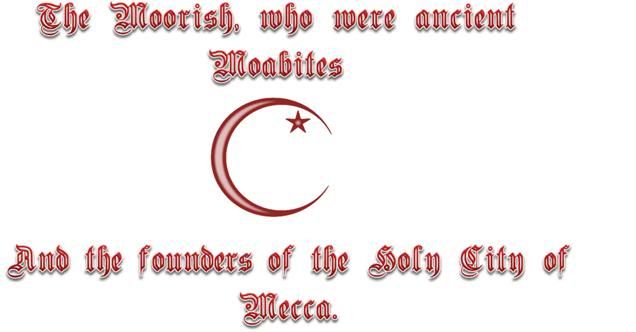
Islam (Peace)and greetings to you all.
In this essay, we will expound upon another critical piece of history as was given us by our Holy Prophet, Noble Drew Ali (May the Peace and Blessings of Allah Eternally be Upon Him). The above cited “The Moorish, who were ancient Moabites, and the founders of the Holy City of Mecca” which can be found in the Holy Koran of the Moorish Science Temple of America at Ch. 45 v. 2, is one of those elusive topics pertaining to our Moorish history as presented by our Prophet Noble Drew Ali. A lot of this information regarding the Koran of the Moors (also called the Circle 7 Koran) has been vague at best for the better part of 90 years and it has been through the guidance of Allah and the teaching of Prophet Noble Drew Ali that we new Moors whom the Prophet prophesied would come in one day eyes wide open, have been able to uncover the most of it. The weighty evidence of this subject will in and of itself give some conformation to the claims made by our Prophet and our Moorish origins (whom some call black or African) of Arabia which has been washed out by supplants to the region of Arabia over the past 2000-3000 years not to mention, the scholars who "whitewashed" history. We find the same thing in Colchis, Libya, Morocco, Tunis, Algiers etc., where the original Moorish inhabitants are not to be found and if found, in traces living in abject poverty.
Because of this, presenting physical proof of the Moabite founding of Mecca caused me to look at extraneous but intimate primary substantiation outside of the current occupiers of the Holy City and the region in general. The first thing I did was looked into the language, and then I looked into the Gods of pre-Islamic Arabia. Thanks to the works by sisters like that indefatigable scholar Dana Marniche and brothers like Wesley Muhammad, who are expert scholars on pre-Aryanized and Euro-Christianized Islam and the region it corresponds with, namely Arabia, a lot of the research for this note was easy to piece together. Certain aspects however, were a little more difficult.
Now to give some credence to the claim. In the book Egyptian Romany: the essence of Hispania, By Moustafa Gadalla on page 150 we read:
“This combined alliance of rulers [Berbers and Arabs], mercenaries, and tax collectors had a common origin – the Moabi desert region. Diodorus, Book I, [28, 1-4], tells of an Egyptian colony at present-day Moab, which is the origin of the Arab and Jews who collaborated to govern in Iberia,
‘... that the nation of the Colchi in Pontus and that of the Jews, which lies between Arabia and Syria, were founded as colonies by certain emigrants from their country [Egypt]; and this is the reason why it is long-established institution among these two peoples to circumcise their male children, the custom having been brought over from Egypt."
The location mentioned by Diodorus is the vicinity of the Moab. This location of Moab is very important in understanding the identification of the Moorish alliance, and thus the dynamics and history in Iberia. Moab is the origin of three groups – Arabs (Syrians), Berbers, and Jews – that joined forces to control Moorish Spain.”[added emphasis mines]
This coincides directly with the lost historical accounts as given to us in Chapter 47 verse 6 of the Holy Koran of the Moorish Science Temple of America (Circle 7) by Prophet Noble Drew Ali where it says and I quote:
“The Moabites from the land of Moab who received permission from the Pharaohs of Egypt to settle and inhabit North-West Africa; they were the founders and are the true possessors of the present Moroccan Empire. With their Canaanite, Hittite, and Amorite bretheren who sojourned from the land of Canaan seeking new homes.”The very fact that the Hittites represent a ruling class among the ancient Moors and were once regarded as hereditary rulers of the world is evidence by our words Kaiser, Czar, Caesar, Castle (abode of Kassites), Castilla (a name of Spain), Cadiz (a Spanish city), Cathay (China), Catholic (Universal), Cathedral (Hittite Temple) Chateau (Hittite Manor House), Satrap, cash (the money issued by the leaders), Cossak, Kazar, Goth, etc., plus similar terms existing among Native Americans. For example, among the Eskimos, village buildings used for ceremonial and governmental purposes are called Kashim. Several sources list them as Cushites(Matlock 2000 pg. 73).
In the same manner we find the Amorites that Noble Drew Ali claimed joined the Moabites in Morocco and those other North African Kingdoms, and also here in the west. Sources list the Amorites as the "mothers of Jerusalem" and are called Maruts or Maruta(another linguistic root on today's word Moor?) who were viewed as mythic demigods in ancient Indic lore. These Amorites appear side by side with the ancient Hittites, Kassites and Cushites throughout the ancient world (Matlock pg. 29-30).
We can cross reference this by looking at several sources as well where we find the Moslem armies who conquered Spain cited as Moors, Moabites, Saracens, Ethiopians, Parthians, Africans, Persians[1] Hagarenes, pagans, Ishmaelites, Chaldeans, and Amorites.[2]. This is the collective Mohammedan nation whom were called Moors, Hagarenes and Saracens and why Moors have a picture of SULTAN ABDUL AZIZ IBU SUAD within the pages of our Moorish Koran. It stems from an ancient relationship that most do not understand until now.
We read further in Egyptian Romany on page 150 that:
“The Moabi region was also the source of the Arabic, Hebrew, and Aramaic/Syriac dialects, which were offshoots of the Ancient Egypt language. Ibn Hazm (died 1064), the medieval Arabic scholar of Córdoba, recognized that Aramaic/Syriac, Hebrew, and Arabic were kindred dialects, derived from the Mudar, the dialect in which the Koran had been disclosed. Later in chapter 12, we will show that Mudar is an Ancient Egyptian term meaning language, and that all three languages/dialects are offshoots of the Ancient Egyptian language. The Moorish alliance never forgot their Moabi origin. Christian chronicles sometimes referred to the Almoravids as “Moabites”. There are numerous references to the “Moabites” in the Chronica Adephonsi [e.g. [35], [42], [53], [96], [127]; the references are to paragraphs] and the reference to “Ali” and “Texufinus (Tashufin) as kings of the Moabites would seem to support their theory that this term refers to Almoravids” [any emphasis mines]
Now, if any have seen the video we have compiled entitled “THE ANCIENT CANNANITES, Pt. 2, The Moabites”
We see unequivocal proof that the Moabites, who are indeed the Moors of North Africa also called by their "Semetic" ancient designation, “Berbers” as being one and the same. The Egyptian relationship to the Moors or Moabites was also noted by one of our luminaries in the reconstruction of our history, who wrote the book STOLEN LEGACY, one George. G.M. James, says on pages 31-32:
“During the Persian, Greek and Roman invasions, large numbers of Egyptians fled not only to the desert and mountain regions, but also to adjacent lands in Africa, Arabia and Asia Minor, where they lived and secretly developed the teachings which belonged to their mystery system. In the 8th century AD the Moors, i.e .natives of Mauritania in North Africa, invaded Spain and took with them, the Egyptians culture which they had preserved. Knowledge in the ancient days was centralized i.e., it belonged to a common parent and system, i.e. the Wisdom Teachings or Mysteries of Egypt, which the Greeks used to call Sophia.
As such, the people of North Africa were the neighbors of the Egyptians, and became the custodians of Egyptian culture, which they spread through considerable portions of Africa, Asia Minor and Europe. During their occupation of Spain, the Moors displayed the considerable credit, the grandeur of African culture and civilization. The schools and libraries which they established became famous throughout the Medieval world; science and learning were cultivated and taught; the schools of Cordova, Toledo, Seville and Saragossa attained such celebrity, that they, like their parent Egypt, attracted students from all parts of the Western world; and from them arose the most famous African professors the world has ever known, in medicine, surgery, astronomy and mathematics. But these people from North Africa did more than merely distinguish themselves in Spain. They were really the recognized custodians of African culture, to whom the world looked for enlightenment. Consequently, through the medium of the ancient Arabic language, philosophy and various branches of science were disseminated: (a) all the so-called works of Aristotle in Metaphysics, moral philosophy and natural science (b) translations of Leonardo Pisano in Arabic mathematical science (c) translation by Gideo a Monk of Arezzo in musical notation.
In addition, the Moors kept up constant contact with mother Egypt: for they had established Caliphates not only at Baghdad and Cordova, but also at Cairo in Egypt. (Europe in the Middle Ages by Ault p. 216-219) Just here it would be well to mention that all the great leaders of the great religions of antiquity were Initiates of the Egyptian Mystery System: from Moses, who was an Egyptian Hierogrammat, down to Christ.”
So it is clear, according to John G. Jackson’s research, that the Moors whom recaptured Spain, for history shows that this was once a Moorish land[3], the Moabites, also called Berbers, were indeed the preservers of the Egyptian mysteries system and produced the wonderful edifices like the Alhambra as proof of this claim. We continue to read from page 169 of Egyptian Romany:
“Tracing the history of the Arabic language will lead us to Ancient Egypt. Ibn Hazm, the medieval Arabic scholar of Córdoba (d. 1064), recognized that Aramaic/Syriac, Hebrew and Arabic were kindred dialects, derived from the Mudar, the dialect in which the Koran had been disclosed. The original home of Arabic – the Arabic of the Koran – came from the Northwestern Arabian Peninsula. These three kindred dialects (Aramaic/Syriac, Hebrew, and Arabic) originated from the Moab region, which was under control of Ancient Egypt [discussed in chapter 11]. It is therefore a logical step to consider the role of the Ancient Egypt language, as it relates to the later formulated Arabic language. To decipher the Ancient Egyptian language and its grammar and syntax, modern-day Egyptologists studied the Arabic language. They assumed that Arabic, being an offshoot of the Ancient Egyptian language, would share much of the same grammar/syntax and vocabulary. It was generally the right assumption and thus Egyptologists were able to address the subject of the Ancient Egyptian grammar and syntax. The Ancient Egyptian-controlled Moabi region is regarded as the home of the Mudar language, the forerunner of Arabic. The name Mudar is an abbreviated form of the ancient Egyptian term, Medu-Neter, meaning the words/language of angels/gods. It is no accident that Moslems say that Arabic is the “language of Angels”, in imitation of the Ancient Egyptian Medu Neter. The people of this ancient Egyptian colony (Moabi) spoke and wrote the Egyptian language. Scripts found in the Moabi region look exactly like the Ancient Egyptian demotic style of writing. [as shown on page 186-7]. The Egyptians were the only people in the Moabi region who had an available writing surface (papyri), and its associated writing tools of pens and inks. When Ancient Egypt lost power in Asia, there was no one to maintain a literate Mudar Language, and as a result no more than a handful of written texts were found, because writing was/is not part of the nomadic life – a fact that was also affirmed by Ibn Khaldun in his Muqaddima, as shown in the last chapter of this book.”[added emphasis mines]
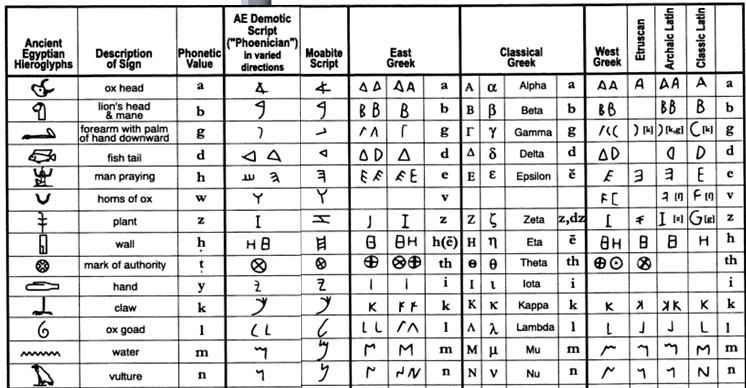
As you can see in the chart above, taken from said book, and as he mentions on page 170, the Moabite language Mudar and the Demotic are one and the same would have been no doubt nearly exact in pronunciation to certain original Egyptian words but with the insertion of vowels as is common with spoken communicative speech. It is also clear to conclude that in the Moabite region, those Moors developed a language based on the Egyptian spoken language as true descendants of the "original" Egyptians (Hamathites). These were probably the Moors that were displaced from lower Egypt who worshiped Set who juxtaposes with the ancient Canaanite God Baal.
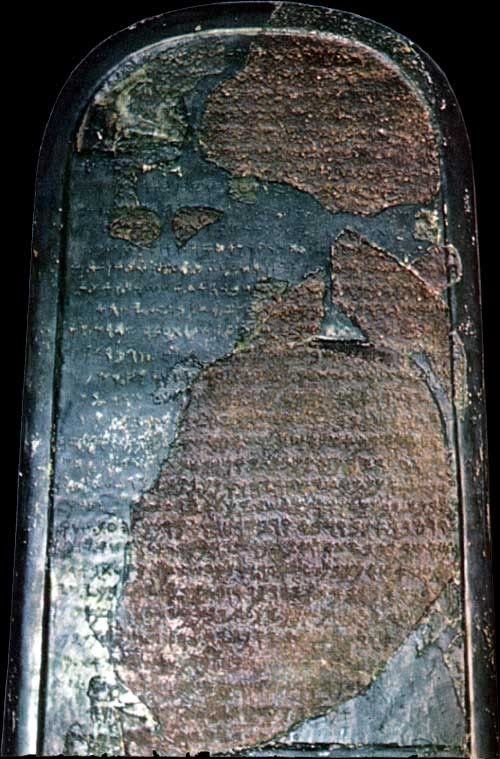
Renowned Arabic scholar Anwar Chejne, concerning the origins of the Arabic language, stated:
“As mentioned before, the original home of Arabic – the Arabic of the Qur’ān and of literature – may be traced to the northwestern region of the Arabian Peninsula… The northern region is regarded as the home of the Mudar language, the forerunner of Arabic; and the southern region is considered the locus of the Himyarite language spoken by the Yemenites and their neighbors. This division became more pronounced after the rise and expansion of Islām, when the Mudar language was accorded supreme attributes and superior qualities. Such views were rationalized by pointing to the fact that the Qur’ān was revealed in one of the Mudar dialects, the dialect of the Quraysh tribe.”
Arabic (as it is spoken today) follows the ways of the Mudar language. The only loss is that of the vowels indicating the distinction between subject and object. Instead, one uses position within the sentence and syntactic combinations (qara'in) to indicate certain special meanings one wants to express. However, the clarity and eloquence of the Mudar language are greater and more firmly rooted (than those of present-day Arabic)… Therefore, Arabic speech is more concise and uses fewer words and expressions than any other language. This is what was meant in the following remark by Muhammad: "I was given the most comprehensive words, and speech was made short for me." (Ibn Khaldun, Muqaddimah 13th century)
Concern 2 for the Mudar language was only felt when that language became corrupt through the contact of the true Arabs whom were Moors, with non-Arab transplants, at the time when the Moors gained control of the provinces of Iraq, Syria, Egypt, and the Maghrib. At that time the Arabic linguistic habit took on a form different from the one it originally had. The Mudar language was thus transformed into another language. Now, the Qur'an was revealed in the language of the Mudar, and the Prophetical traditions were transmitted in it, and both the Qur'an and the traditions are the basis of Islam. It was feared that, as a result of the disappearance of the Mudar (Moabite) language in which they were revealed, they themselves might be forgotten and no longer be understood. Therefore, a systematic treatment of its laws, a presentation of the analogical formations used in it, and the derivation of its rules were needed. Knowledge of Arabic thus became a science with subdivisions, chapters, premises, and problems. The scholars who cultivated that science called it grammar and Arabic philology. It became a discipline known by heart and fixed in writing, a ladder leading up to the understanding of the Koran and the Sunnah of the Prophet Mohammad (PBUH). The relationship of the Mudar language to the Himyarite language was of the same type. Many of the meanings and inflections of the words of the Himyarite language were changed in Mudar usage. This fact is attested by the transmitted material available to us. It is contrary to the opinions of those whose deficient (knowledge) leads them to assume that the Mudar and Himyar languages are one and the same, and who want to interpret the Himyarite language according to the formations and rules of the Mudar language.[4]
The close connection of the Moabites and the Egyptians has been duly noted in previous works of mines like the video I cited above in where empirical evidence is shown in the form of archaeological relics. The Balu’a stele, which dates back to around the 13th century B.C., shows a Moabite ruler being given the scepter of rule by an Egyptian Pharaoh and Goddess deity.

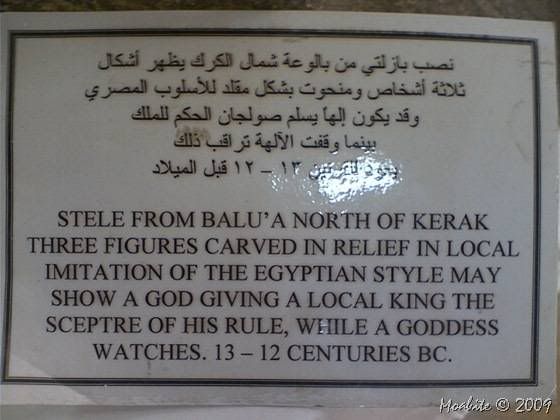
So when Prophet Noble Drew Ali informs us in chapter 47 verse 6 of the Moorish Koran that:
“The Moabites from the land of Moab who received permission from the Pharaohs of Egypt to settle and inhabit North-West Africa; they were the founders and are the true possessors of the present Moroccan Empire.”Then we now have empirical data that suggest such a relationship existed between Moab and Egypt and can reasonably conclude that the original inhabitants of Moab emigrated to when the lighter skinned nations (Joshua) took over that ancient dominion of the old world.
One of the mystical cities as cited in the pyramid texts dating back to as early as 2400-2300 BC, speaks of a place called Bekka. According to E.A. Wallis Budge and his version of the Pert Em Heru (the coming forth by day) or as he calls it, “THE BOOK OF THE DEAD” we read in the introduction entitled THE PRINCIPLE GEOGRAPHICAL AND MYTHOLOGICAL PLACES IN THE BOOK OF THE DEAD, on page cxxxiii, we read:

We also find in this crossed referenced and confirmed in An Egyptian Hieroglyphic Dictionary Vol II: With an Index of English Words, King List, and Geographical List with Indexes, List of Hieroglyphic Characters, Coptic and Semitic Alphabets, pg. 978 By E. A. Wallis Budge
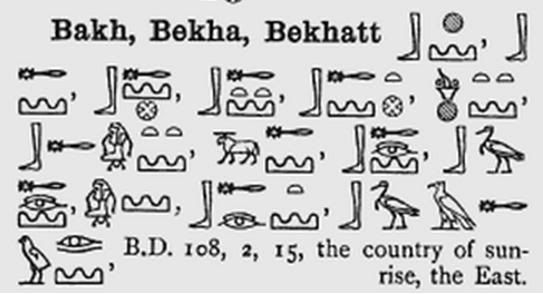
We see that Bekha is a synonym for the east according to the ancient Egyptians. Conversely, Bekka, is also the original name of Mecca. Bekka, like Mecca, is of “unknown” derivation according to today’s etymologists. Myself not being a scholar or a linguist, nor wanting to be accused of pushing a square peg through a round hole, cannot help but to place Bekka in Mecca in the land of Canaan, that is, Arabia. Of course much more study needs to be done on this point alone but what I have noticed is that where etymologists are unsure, something is usually being concealed and you could only imagine if the Moors of America woke up to the fact that they are the Moabites, and the founders of the ancient city of Mecca, what type of implication this would cause on the Aryanized grip on Islam and the city of Mecca itself. Look at what the Egyptians called Arabia "THE LAND OF GOD". This alone has so many implications but we will not touch on it all here.
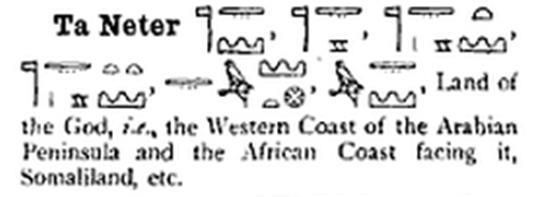
An Egyptian Hieroglyphic Dictionary Vol II: With an Index of English Words, King List, and Geographical List with Indexes, List of Hieroglyphic Characters, Coptic and Semitic Alphabets, pg. 978 By E. A. Wallis Budge
The parallels here illume themselves when we consider and weigh the evidence above cited, which proves an ancient connection with ancient Egyptians and the Moabites particularly the language spoken by the Moabites, which is Mudar, the same said to be the “demotic” which is a Greek word that means “popular” (possibly referring to the widely spoken Canaanite tongue) but was referred to by the Egyptians as sš n šˤ.t which means "document writing" thus coined by the early Moabites by the name Mudar, as an ode to its roots being Medu-Neter, and the fact that you find archaeological evidence of Moabite rulers, Pharaohs, and deities together upon artifacts, makes a strong argument that these indeed were one people, and quite possibly represents the parent root of the Egyptian civilization. We confirm the ethno-identity of the Moabites by the oldest known Moabite artifact called the Shihan stele which shows what appears to be a Moabite warrior, chief or God that dates back to 3000-2500 B.C. a time associated with Egypt’s first and second dynasties.
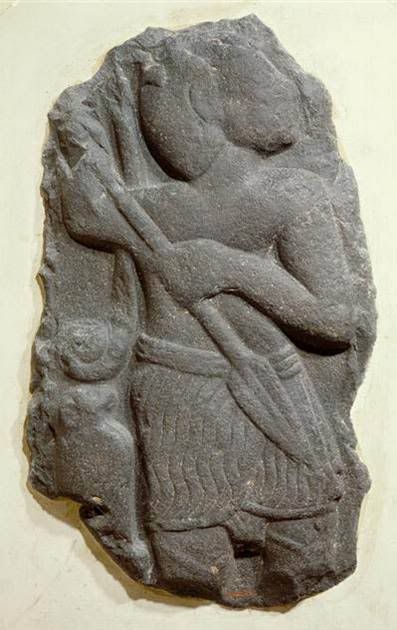
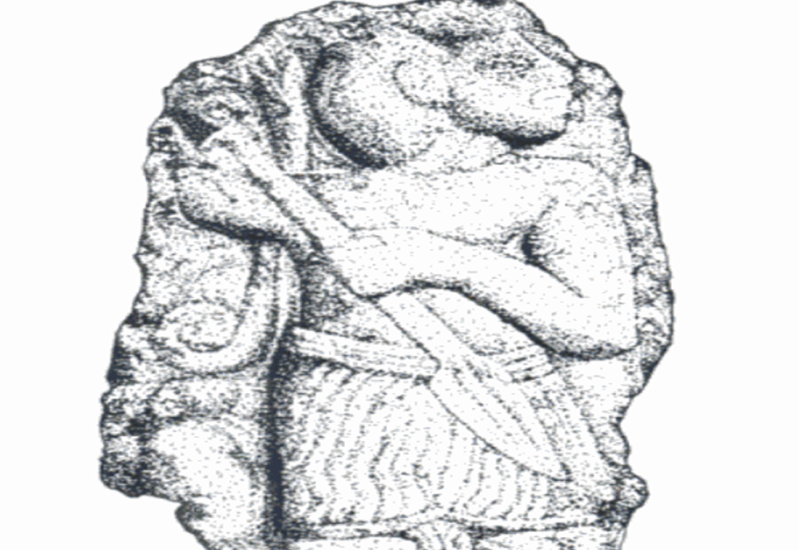
The kilt of this figure appears to be the same style as the Egyptians and we find such spears, and afro’s among the wooden model of a company of Cushite spearmen fighting for the Egyptian, Dynasty 11-12, ca. 2040-1780 BCE.
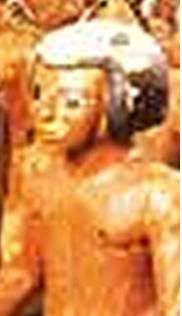
So I have "theoretically" concluded that the Bekha that was synonymous with a mountainous region in the east (ancient Moab was a mountainous region) judging by the glyph of said name, which in later years became Mecca because of a consonant shift, may justly be a transplant name from an earlier source in the Moab region recognized by the Egyptians, which undoubtedly would be in a considerably nearer proximity than modern day Mecca which would be seen east of Egypt whom the Moabites kept up a close relationship with even unto their inhabitation in North Africa. That area was known to the Romans as "ARABIA DESERTA" to which we will highlight later on in this dissertation. We must also add that, one of the earliest known names for Mecca is Mesha, who is in fact the God of the Moabites whose accounts, although distorted, are copied into the bible. These are too many factors that cannot be ignored. Even when looking at Chemosh, Chemosh is simply a corruption of the name for the Babylonian Sun God Shamash and, the fact that Chemosh was worshiped in Arabia by the early Moabites or Arabians as a black stone coupled with the fact that the black stone of the Kaaba is venerated, it is hard to believe that these names have no connection to each other representing one and the same people.
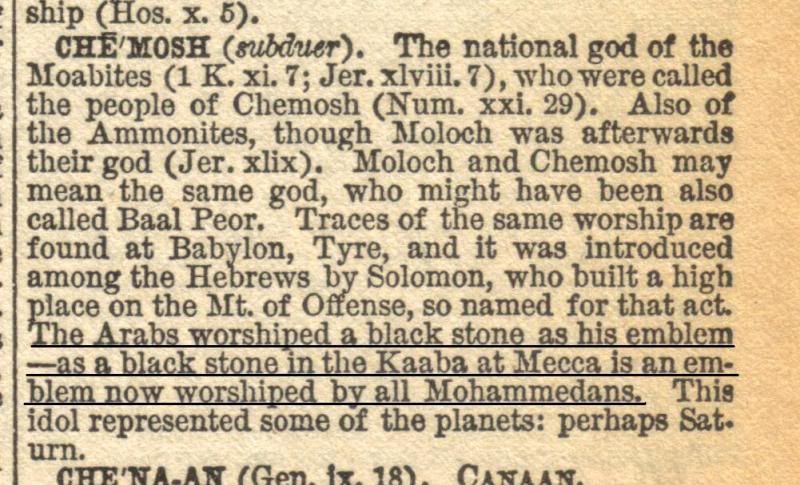
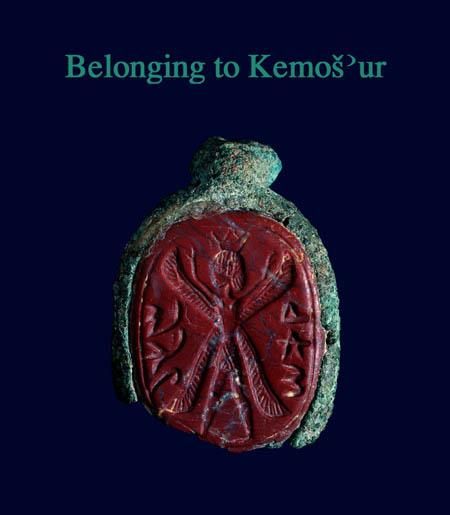
According to Islamic tradition, the history of Mecca goes back to Abraham (Ibrahim) who built the Kaaba with the help of his elder son Ishmael around 2000 BCE when the inhabitants of what was then known as Bakkah had fallen away from the original monotheism of Abraham through the influence of the Amelkites.[5] There have been many scholars like sister Dana Marniche and other early scholars whose historical version of events, negates these accounts possibly given by dogmatists or those who sought to write our ancestors out of history.
So it is easy for us to reasonably surmise, in spite of the lack of empirical artifacts, that we can still put forth a strong case, that Abraham, whom would without a doubt be an eponymous ancestor to the Moabites, did travel deep into the Arabian desert from the Chaldean region, and built the Kaaba there in a city already known since Egyptian times as Bekha. I am in this instance, just giving good honest theory here based upon the preponderance of evidence as cited above which makes this correlation highly plausible and hardly debatable.
The name Abraham itself means “Father of the Multitudes” and the name Ammon means “multitude” and Ammon was a chief Berber or Libyan God primarily, which may have been adopted into the Egyptian pantheon at a later date, but it is not doubted the Amon was a ancient God of the Berbers (H. Basset, Les influences puniques chez les Berbères, pp 367-368) to whom shrines were said to have been set up on the sunken Island of Atlantis(History of Ethiopia written by Marcellus), and we find ancient shrines to Ammon in the desert of the Siwa Berbers[6] which was no doubt the most famous oracle of Amon, and the ancient city in Canaan (present day Israel) itself, today, known as Amman (corruption of Ammon), Jordan was once named AMMON which is the eponymous brother to Moab according to the biblical tales. The fact that Christians claimed that the Moors worshiped the pagan God Ammon (Gwynn, Bangert 2010, pg. 487), gives us more weighty evidence.
Again, such correlation from a historical, eponymous, and etiological-mythos standpoint, simply cannot be ignored. Ammon is also the self-same as Amen Ra of Egyptian fame who was worshipped at the city of No (Thebes) in ancient Egypt as well. He was honored by the Ancient Greeks in Cyrenaica, and was united with the Phoenician (Canaanite) God Baal due to Libyan influence.[7] Some depictions of the ram across North Africa belong to the lythic period which is situated between 9600 BC and 7500 BC. The name of the ancient Berber tribes: Garamantes and Nasamonians are believed by some scholars to be related to the name Amon.[8]
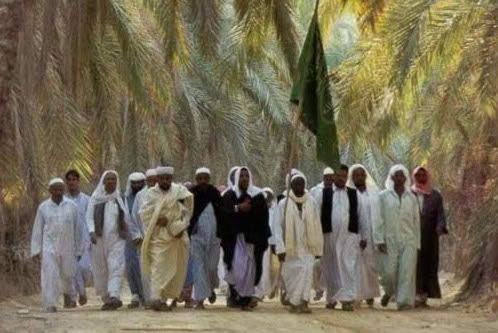
Many EARLY sources highlights the original Arabian Moabite connections. I will bring you to the book "An introduction to the critical study and knowledge of the Holy Scriptures VOL. III, Volume 3" By Thomas Hartwell Horne. On page 8 we qoute:
“The inhabitants of Arabia, who dwelt there before Abraham came into Canaan, are supposed to have descended from Ham. We find there Midianites, of the race of Cush, among whom Moses retired. Abimelech, king of Gerar, is known in the time of Abraham; and the Amelekites, in the Time of Moses. The Hivites, the Amorites, the Kenites, and the Meonians, or the Mahonians, extended a good way into Arabia Patraea; the Horim occupied the mountaints which lie south of the land of Canaan, and east of the Dead sea. The Rephaim, Emim, Zuzim, and Zamsummim (Gen. xiv. 5; Deut. Ii. 10, 11.) inhabited the country called afterwards Arabia Deserta [The Romans called it by this name], and which was subsequently peopled by the Ammonites, Moabites, and Edomites."
“The second Arabians who succeeded these are the descendants of Ishmael, the son of Abraham and Hagar, who came and settled among the ancient Arabians, and was father of the mixed Arabians, or Mota-Arabes, Mosta-Arabes, or Ishmaelites. The pure and ancient Arabians were divided into tribes, as well as the sons of Ishmael. Some of these tribes still exist in Arabia, others are lost and extinct.”
Arabia Deserta was one of three regions into which the Romans divided the Arabian peninsula: Arabia Deserta, Arabia Felix, and Arabia Petraea. As a name for the region, it remained popular into the 19th and 20th centuries. So it is evident, according to the source cited above that, what was known as ARABIA DESERTA by the early cartographers and archaeologists, was subsequently peopled by the Ammonites, Moabites, and Edomites which congruously existed in the land via waves of migrations and from this, history records certain names from certain time periods. This gives credence to the claim made by our Holy Prophet, Noble Drew Ali that the Moabites are the founders of the present city of Mecca and why Sultan Abdul Aziz Ibu Suad listed as “The descendant of Hagar, now the head of the Holy City of Mecca” In the Moorish Holy Koran. The Hagarenes in this instance, represent a lighter skin hue peoples married into the tribes of the eponymous Abraham, the father of the multitudes which no doubt represents the early Moors of this region who are truly the fathers and mothers of all nations on the earth. Hagar means “stranger” and we find that the original Arabs did not see lighter nations on equal footing with them and called anyone of a lighter hue, “non-Arabs”.[9]. Abraham’s first wife was named Sarai. Her name means “princess” denoting royalty possibly of the original inhabitants and bloodline of these ancient Moabites. The bible greatly alters the accounts by saying Ishmael was born first by Abraham’s second wife, Hagar. Christian writers collectively called Moabites and Hagarenes “Saracens.”[10][11][12][13][14][15][16]
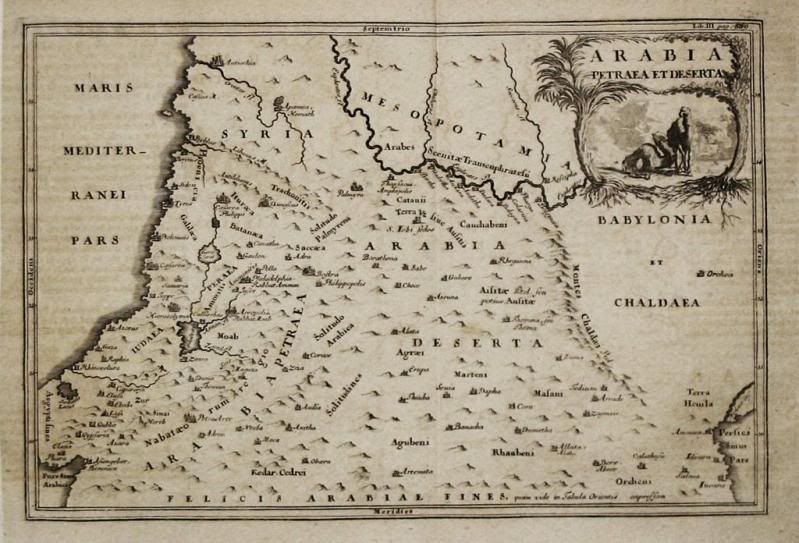
As noted in my video, “Ancient Canaanites pt. 2: the Moabites”, and the video on the origin of the Moors, Abraham descended from Chaldea who were a branch of Hamites, the oldest of our race, that relocated to and I stress, the biblical region of Canaan which is called today Palestine and Israel proper. While in Canaan, they established the city called “Ar” which is a direct phonetic contradistinction to “Ur” of Chaldees.
Let us analyze the word Ur:
MEANING OF THE NAME “UR”:
• Light - The Hebrew word ‘ur translated as “Ur” is thought by many to mean “flame”. This may be derived from the Hebrew word ‘owr, which means “illumination or (concrete) luminary” light.” (OT:216 Strong's Expanded Greek-Hebrew Dictionary)
• Waking - The implication of “light” may be the origin of the Hebrew word ‘ur, which means “opening the eyes, to wake.” (OT:5782 Strong's Expanded Greek-Hebrew Dictionary) One lexicon defines this as “a place guarded by waking or a watch) in the widest sense (even of a mere encampment or post).” (OT:5892 Strong's Expanded Greek-Hebrew Dictionary)
• City – The implication of “waking” may be the origin of the Hebrew word `iyr which is translated as “city”. One lexicon states, “Various other etymologies have been proposed: some taking the word as … the Sanskrit ur, a town, or even the Hebrew ‘iyr.” (“UR” McClintock and Strong Encyclopedia) The Moabite word ‘Ar means “city.” (“AR” McClintock and Strong Encyclopedia) The Hebrew word Uru appears to be related and is defined as “city.” (OT:3389 Brown-Driver-Briggs Hebrew and English Lexicon) A reference work describing the origin of the word “Jerusalem” states, “The oldest known form, Uru-sa-lim, has been considered by many to mean either the ‘City of Peace.’” (“JERUSALEM” International Standard Bible Encyclopedia)
• The chief city - These references may indicate that Ur was not simply a city of the Chaldeans, but was the CHIEF city of the Chaldees. The Moabites named their CHIEF CITY by the related word ‘Ar. One reference describes ‘Ar as “The chief city (as the name means) of Moab.” (“Ar” Fausset's Bible Dictionary)
• Another reference work states, “The Chaldeans were a warlike, aggressive people from the mountains of Kurdistan. Apparently they were Haldians (or Khaldians).” (“CHALDEANS” The New Unger's Bible Dictionary) This derivation may indicate that the Chaldeans were descendants of the one who “captured” many of the cities of Mesopotamia. Perhaps the phrase “Ur of the Chaldeans” should best be translated as “the chief city of the one(s) who capture”.
The Wolof word for a Moor is Nar which comes from from the "Semetic" root 'ar' to which this researcher asserts is the first compound of the word AR'AB of where we get Arabia from.
The very name Ar is directly connected to the name Ra as both are represented by an eye, a descriptive for light and also a city. Osiris, whose name can be read as was+ir, where the eye represents the sound 'ir'
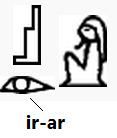
and that according to Massey, Ar becomes Al in the "Semetic" tongue (A Book of the Beginnings, Volume 2 pp. 71, 75, 203, 294, 409) which gives us the word El and, the fact that the Moorish Americans today trace their descendants as the ancient Moabites who inhabited the Northwestern and the Southwestern shores of Africa and, the fact that they wear annexed to their given names 'EL' for their national designation (much like Jews have "stein" as the root of their surnames) the parallels astound.
According to the biblical context, the Moabites city was called Ar who had a river named the Arnon. Among early scholars, the three oldest peoples in the world were the Ethiopians, the Egyptians, and the Arii. The double 'ii' is a Roman suffix denoting plurality. Apuleius, the famous Latin prose writer who was half Berber and half European, in his book The Golden Ass, cites a text where Isis is allegedly edifying herself. It says:
“ the Ethiopians, the Arii and the Egyptians skilled in ancient learning, worshiping me by ceremonies perfectly appropriate, call me by my true name, Queen Isis.” (M.P. Hall 1926 pp. 119-120)
Gerald Massey in his The Natural Genesis: Two Volumes in One on page 22 says this of the Arii:
"The Ari in Egyptian are the companions, the watchers who became the seven Kab-ari, as the Ari of Kheb (Egypt), or from Kab (Eg.) to revolve together. The Ari of Khep or Heb would account for the name of the Iberii in Africa and Ireland, and the Kam-ari, or Kymry or Wales. The Ari were Kamite Blacks before they were the Median Arioi or the Aryas of India. Apuleius mentions the Arii as an African race together with the Ǽthiopians or Kushites of the Persian Gulf, and the Egyptians."
It becomes clear via the biblical narrative that the placing of the Moabites in the city of Ar albeit the bible's historical events are largely actual accounts greatly altered and which are told eponymously and as etiological myths, is merely connecting the Moabites to the most ancient branch of mankind. We teach that the Moors were the first people of the world and that Moor and Moabite are synonymous terms.
The very fact that early Christian writers also called the Moors of north west and south west Africa, that invaded Spain “Chaldeans”[17] proves that they knew whom their warrior adversaries were and coincides with the Abrahamic lineage so touted in religious texts. Couple this with the first oppressor of the "biblical" Israelites ((Judges 3:8), whose name is given as Cushan Rishathiam which means Dark one of double wickedness (Holman 1991) (obviously referencing ancient Cushites) who was the king Aram Naharaim (Northwest Mesopotamia) and the picture becomes more vivid as to the ancient hatred between the European branch of humanity versus the progenitors of humanity, the Moorish.
Even the languages connect to each other. Proto-Berber is the reconstructed proto-language from which the modern Berber languages stem. Proto-Berber was an Afroasiatic language, and its descendants (the Berber languages) are sisters to the Egyptian language, Cushitic languages, Semitic languages, Chadic languages, and the Omotic languages[18].
According to the Christian bible and its Torah, the Midianites conspired with the Moabites to curse Israel (Num 22:1-7). When the curse was turned into a blessing instead (24:10-11), the Moabite and Midianite woman agreed to seduce the Israelite men and in doing so enticed them to serve their idols (25:1-9, 31:15-16, Rev 2:14). The Israelites who fell prey to this and engaged in idolatry were also held responsible, and were executed (25:4-5).
Numbers 31:7-18
"They fought against Midian, as the LORD commanded Moses, and killed every man. Among their victims were Evi, Rekem, Zur, Hur and Reba - the five kings of Midian. They also killed Balaam son of Beor with the sword. The Israelites captured the Midianite women and children and took all the Midianite herds, flocks and goods as plunder. They burned all the towns where the Midianites had settled, as well as all their camps. They took all the plunder and spoils, including the people and animals, and brought the captives, spoils and plunder to Moses and Eleazar the priest and the Israelite assembly at their camp on the plains of Moab, by the Jordan across from Jericho. Moses, Eleazar the priest and all the leaders of the community went to meet them outside the camp. Moses was angry with the officers of the army - the commanders of thousands and commanders of hundreds - who returned from the battle."
So here, we can see a relationship between the Moabite woman and the Midianite woman being noted in the bible as working in unison. The Midianites were undoubtedly Cushite Arabians as Moses took a wife from among the Midianites and was scorned for such by Aaron[19]. The fact that the name HUR is mentioned as one of the five kings, which is Ur or Ar and even deeper, is Hor meaning Lord and Horus as well(Massey Book of the Beginnings vol 2. pp. 104, 269 etc., etc.) is an obvious allusion to the connection of one people to which these names more than likely represent locations in ancient Arabia.
According to two Islamic hadith given by Sahih Muslim and Jami` at-Tirmidhi Prophet Mohammad's tribe, the Quraiysh, was born out of the Banu Kinanah or the Sons of Canaan. The name which appears on the Amarna and Mesopotamian tablets is "KI-NA-NHU" and "KI-NA-AH-NA." Some sources have shown that, when deciphering the MDW NTR (Egyptian Hieroglyphs), they turned to the Arabic solely because the Arabic was derived from the Mudar which indeed was an ancient Moabite language. I have read several sources that make the claim that the Banu Kinanah are indeed Canaanites and some sources who wholly refute this claim. The breadth of the argument is too lengthy to put in this particular treatise but it does warrant notation.
Now, the early Moabite - Mecca/Arabian connection. Hubal was a Moabite deity imported into Mecca and was the chief deity in Mecca before Allah. Hubal was one of the 360 idols found in the Mecca and destroyed by Prophet Mohammad. This historical fact, that Hubal is a Moabite deity, is almost never spoken about among orthodox Islamic scholars. A quick point to note is that, at one point, El was the chief God of most of the Levant. At some point, Baal became the chief God with magnificent Temples erected to him, but none are found of his father El, and those whom we know as Hebrews, who invaded Canaan, crushed Baal worship and implemented the worship of Yahweh as the chief deity although, El is THEE GOD of the bible.
It would perhaps be a good idea to introduce the reader to a brief explaination of how idolatry in pre-Islamic Arabia was practiced and the cited origins of Hubal:
"Every tribe had a different idol which it worshiped. Generally, objects of worship belonged to three genres: metal and wooden statues, stone statues, and shapeless masses of stone which one tribe or another consecrated because its origin was thought to be heavenly, whereas in reality it was only a piece of volcanic or meteoric rock."[20]
Hence it is acknowledged that each Arabian tribe had its own “chief idol” to which they would worship. With regard to the position of Hubal, it is noted that:
"Hubal was the greatest member of the Arab pantheon and resided in Makkah, inside the Ka’bah. Pilgrims came to its shrine from all corners."[21]
Regarding the nature of Hubal, it has been ascertained traditionally that the idol is Moabite in origin. Martin Lings (also known as Abu Bakr Siraj Ad-Din, 1909–2005) was an English Muslim writer and scholar, states as follows:
"So ‘Abd al-Muttalib continued to dig without any actual move being made to stop him; and some of the people were already leaving the sanctuary when suddenly he struck the well’s stone covering and uttered a cry of thanksgiving to God. The crowd reassembled and increased; and when he began to dig out the treasure which Jurhum had buried there, everyone claimed the right to share in it. ‘Abd al-Muttalib agreed that lots should be cast for each object, as to whether it should be kept in the sanctuary or go to him personally or be divided amongst the tribe. This had become the recognised way of deciding an issue of doubt, and it was done by means of divining arrows inside the Ka’bah, in front of the Moabite idol Hubal…"[22]
Hence it has always been known that the idol Hubal is a Moabite import (i.e. Baal). One source states:
"Hubal (from Aram. for vapour, spirit), evidently the chief deity of al-Ka’bah, was represented in human form. Beside him stood ritual arrows used for divination by the soothsayer (kahin, from Aramaic) who drew lots by means of them. The tradition in ibn-Hisham, which makes ‘Amr ibn-Luhayy the importer of this idol from Moab or Mesopotamia, may have a kernel of truth in so far as it retains a memory of the Aramaic origin of the deity. At the conquest of Makkah by Muhammad Hubal shared the lot of the other idols and was destroyed."[23]
These clear references coincide again with the biblical accounts to which Balak, the king of Moab, calls Baalam the Prophet, who is coined the "diviner" (Num 22:7, Josh 13:22). We should also note the etymology of the name Hubal which means "spirit of Baal" from 'Hu' meaning spirit and the Maob god Baal meaning "master" or "lord". Outside of South Arabia, Hubal's name appears just once, in a Nabataean inscription[24]. Nabateans, according to Dana Marniche's (Reynolds) finds in Ivan Van Sertima's Golden Age of the Moors, detailing the ethnohistory of the Moors, on page 105 says that the Nabateans of Petra were called Amorites. The Nabateans were a tribe of Moors of Arabia. When the Prophet Noble Drew Ali says at Ch. 47 v. 6 of our Moorish Holy Koran:
"The Moabites from the land of Moab who received permission from the Pharaohs of Egypt to settle and inhabit North-West Africa; they were the founders and are the true possessors of the present Moroccan Empire. With their Canaanite, Hittite, and Amorite bretheren who sojourned from the land of Canaan seeking new homes."
We then see a myriad of connections with these ancient tribes and their relationships in ancient days. The descendants of those whom would come to be known by the name Hagarenes after the biblical/Koranic Hagar, who are called Arabians today, did turn on the Moabites and altered and corrupted Islam into the predominant form that we have now. The works of that indefatigable scholar on pre-Islam and Arabia, Wesley Mohammad, details in depth how Islam went from an original creation by Moors (so called blacks) to an Aryanized, Christianized Euro religion made into some form of spook worship backed with despotic savagery which causes our people in particular, whom founded this great religion, to turn a blind hateful eye towards it[25][26][27][28]. Prophet Noble Drew Ali told the Moors "Islam is yours, that is why you don't recognize it." In this day and time however, Islam is getting a much needed makeover and its essence, its true pristine form, has been resurrected by the Moabites of the West i.e. the Moorish American Moslems in the United States of America and we shall put Islam back at the forefront of the world again but this time it will be done under the five greatest principles known to man; LOVE TRUTH PEACE FREEDOM & JUSTICE.
When we say the Moabites of the west, i.e. the Moors, we dont just mean a people brought over by slave ships, we mean a people who were already here on this land and those who came after. This too is also chronicled in European records on this land where only the Africans who are Ancient Berbers are to be called Negro on this land. Prophet Noble Drew Ali succinctly states in Act 6 of our Divine Constitution and By-Laws of the Moorish Science Temple of America that "The Moorish Americans [so called black people] are descendants of the ancient Moabites who inhabited the Northwestern and Southwestern shores of Africa."
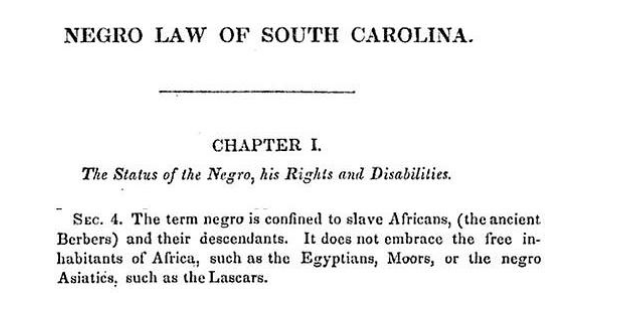
You couple this with the fact that sources state that the Moors, fleeing the Portuguese inquisition fled of all places, to South Carolina, and the picture is finally complete and the teachings of Prophet Noble Drew Ali whom many scholars refuse to even mention for whatever reasons there may be, becomes fruition.
"When the Moors were driven out, thousands took refuge in the South of France, who abhorring the Roman Catholic persecutions, became Huguenots, and that of these many emigrated to a later date to South Carolina..." (Coppee 1881 pg. 445-46)This concludes for now the connecting of the dots of historical information pertaining to the Moabite founders of the Holy City of Mecca that was given by Allah's last Prophet for these days and times, the Most Noble, Prophet Drew Ali. At first, most of the historical information that he gave to us was passed off as made up religious pseudo-babble, one professor on African American studies from Iowa University called it nothing more than "theosophical lore" that had no "historical value" to it but now, after intense research into what he has brought, and the fact that most of it is/was either hidden, erased, or never mentioned in today's academia especially by Afrocentric scholars or just simply unknown, in this researcher's opinion, shows a plot to blot out such history from the books since the coming of our Prophet with a hope that this true accounting of our people would never get out. The proverbial cat is out of the bag now and like the Prophet Drew Ali told us "Wake up you sleepy headed Moors. I am going to take you up above the sun, moon and stars, around the throne of the Mighty Allah." With that, I end this dissertation for the community and welcome any refutation, or add-ons to the above.
THIS IS THE RECLAMATION OF ISLAM BY ITS TRUE FOUNDERS!
"Before the end of time, every knee will bow to Islam" ~ Prophet Noble Drew Ali (PBUH) EYES WIDE OPEN...
I am the message that I bring to you this day...
Love and Peace
Sheik Way-El Grand Sheik and Divine Minister Moorish Science Temple of America Moorish Medina aka Atlanta, Georgia U.S.A.
Sources:
1. The Foreign quarterly review, Volumes 14-15 By William Van Norden (1835)
2. The Medieval state: essays presented to James Campbell By John Robert Maddicott, By David Michael Palliser, James Campbell (2000) pg. 159
3. The Golden Age of the Moor (Journal of African Civilizations) by Ivan Van Sertima (1991)
4.The Muqaddimah: an introduction to history, Volume 1 By Ibn Khaldūn (1377) http://www.muslimphilosophy.com/ik/Muqaddimah/Chapter6/Ch_6_46.htm
5. "Mecca". Catholic Encyclopedia. New York: Robert Appleton Company (1913)
6. Description of Greece x.13 § 3, By Pausanias
7. Revue Tifinagh, Mohammed Chafik
8. Helene Hagan, The Shining Ones: An Etymological Essay on the Amazigh Roots of the Egyptian civilization (2000), p. 42
9. Ibn Abī al-Ḥadīd Sharḥ nahj al-balāghah, ed. Muhammad Abi al-Fadl Ibrahim (Cairo: #Isa al-Babi alHalabi, 1959) V:54Helene Hagan, The Shining Ones: An Etymological Essay on the Amazigh Roots of the Egyptian civilization, p. 42
10. Encyclopaedia Americana: A popular dictionary of arts, sciences (1838)
11. literature, history, politics and biography Volume 9 edited by Francis Lieber, Edward Wigglesworth, Thomas Gamaliel Bradford (1840)
12. The world of El Cid: chronicles of the Spanish reconquest By Simon Barton (2000) pg. 57,
13. The medieval cult of Saint Dominic of Silos By Anthony Lappin (2002) pg. 192 14. The Foreign quarterly review, Volumes 14-15 By William Van Norden (1830) 15. The Medieval state: essays presented to James Campbell By John Robert Maddicott, David Michael Palliser, James Campbell pg. 159
16. The Victors and the Vanquished: Christians and Muslims of Catalonia and Aragon 1050-1300 (Cambridge Studies in Medieval Life and Thought: Fourth Series) By Brian A. Catlos (2004) pg 67
17. Ibid, The Medieval state, Maddicott, Palliser, Campbell 18. Allati (2002:3)
19. And Miriam and Aaron spoke against Moses because of the Ethiopian woman whom he had married; for he had married an Ethiopian woman" (Num. 12:1)
20. M.H. Haykal, The Life of Muhammad (transl. Isma’il R. al Faruqi), (1976) p. 20
21. Haykal, ibid
22. Martin Lings, Muhammad: His Life Based on the Earliest Sources, (1991) p. 11
23. Philip K. Hitti, History of the Arabs, (1949) p. 100
24. Corpus Inscriptiones Semit., vol. II: 198; Jaussen and Savignac, Mission Archéologique en Arabie, I (1907) p. 169f.
25. Wesley Muhammad, PhD ©: The Whites of Arabia According to Black Muslim Orthodoxy and the Classical Arabic Tradition
http://www.facebook.com/note.php?note_id=10150476915542397
26. In Islam Does the Color of the Prophet(s) Matter? By Wesley Muhammad http://www.facebook.com/note.php?note_id=10150278835982397
27. How Did the Black Arabs Become White? (Revised Version) By Wesley Muhammad http://www.facebook.com/note.php?note_id=10150269796717397
28. Accepting the Orthodox Challenge By Wesley Muhammad http://www.facebook.com/note.php?note_id=10150286670712397
Additional sources
1. Jesus and Moses Are Buried in India, Birthplace of Abraham and the Hebrews! By Gene D. Matlock 2000
2. Arabic Language By Anwar G. Chejne
3. An Egyptian Hieroglyphic Dictionary Vol II: With an Index of English Words, King List, and Geographical List with Indexes, List of Hieroglyphic Characters, Coptic and Semitic Alphabets By E. A. Wallis Budge
4. Religious diversity in late antiquity edited by David Morton Gwynn, Susanne Bangert 2010
5. Holman Bible Dictionary 1991
6. The Natural Genesis: Two Volumes in One By Gerald Massey, republished in 2011
7. A Book of the Beginnings, Volume 2 By Gerald Massey, republished 2007
8. History of the conquest of Spain by the Arab Moors vol. 2, By Henry Coppee (1881)
Books by the author
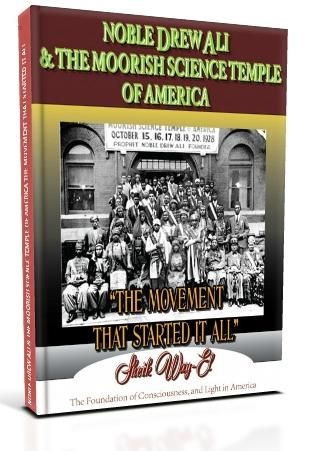

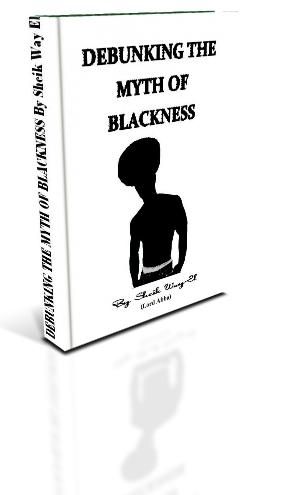

COMING SOON!
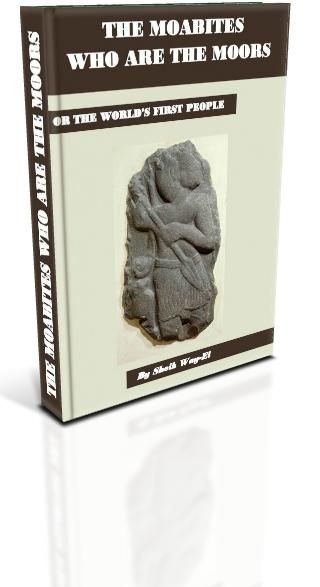
VISIT OUR WEBSITE AT:
www.moorishsciencetemple.org
5 comments:
Bare with me, I just discovered this topic and am researching it. Please keep in mind the scholarly incorrect scripture description of America toda, America is not BABYLON, mystery Babylon is the Vatican or Roman Catholic Church LUCIFERIANISM IDEOLOGY passed on from Babylon. America today by Prophetic Past in correlation to present days is ATLANTIS RISING AGAIN, THE SINS OF LIGHT WHO WERE SLAUGHTERED AND OVERTHROWN, AND/OR PROPHECIES OF THOSE EHO SURVIVED THAT ATKANTIS WOULD SINK IN A CATACLYSMIC FLOOD. BE careful with symbolism trying to understand the past. The past isn't difficult to understand, were all Brethren, and we've all been killing each other by either the Reptilian-Complex vs THE EMPATH SPIRITUAL ENLIGHTENMENT MINDED.Im the Christ-Soul that will walk the earth again and I'm dialed in and in sync with daily dire warning events. It's PROPHETICALY possible I started China's massive military movement and spoiled the whole show by EXPOSING it... CLEVER CLEVER CHRIST-SOUL.
3rd/4th Earth Root Race I'm Africa mated with a more evovled human species on earth progressing them onward to where were together to this day, Anunnaki had milky white skin and had a glow like saphire. This is probably the explanation behind the skin deformity (can't think of proper word, black people having white blotchy skin). The Anunnaki were turned into an ideaology to brainwash and control humans for power. They're not God's nor are they or anything else created in God's image. If that were the case, as you can see today, rulers would all believe themselves to be God's over all of mankind, God looks nothing like human form or anything of nature except the clouds, but not any cloud. God has eyes and that's all that can relate to anything fleshy of our realm. If history is correct, I'm The Tree of ENKI who has survived the entire planet and back to where was years ago. Ancient home North Dakota, Back to Jew-Jew, back again, where was my family before we lived in Ancient Russia, where Russian-Aryan spread and moved on . My family has survived the Planet as we had to constantly be on the run, in fear for our lives, and live 10,000 years as exiles because there's Brainwashed factions that retaliate against what we/I Am, and it's FUCKING PSYCHOTIC AND SINISTER HOW THATS CONTINOUSLY DONE. THE NOW STARTING 6TH ROOT RACE MAY ACTUALLY BE THE SPREADUNG OF MY HUMAN EVOLUTION THATS SURVIVED, BUTS LOST. IM THE UNITED 12 TRIBES OF ISRAEL, NONE SRE LOST WITHON ME.
IM NOT THE SECOND COMING AS THOUGHT OF. IM THE 12TH RETURN OF THE CHRIST-SOUL, 2ND COMING TREE OF DAVID, YOU WANT THE PROPER PATH, SIDE WITH THE THRONE OF DAVID USHERING, BEWARE BEWARE THE CHAIR OF PETER. WHY, IM THE SOUL LAUGHING ON THE TREE, BECAUSE WHY ARE THEY AGAINST ME? THEY DONT BELIEVE IN CHRIST-HOOD.
The ANTICHRIST IS A PHANTOM ANTICHRIST DARK SPIRIT, ANYONE CAN BE AN ANTICHRIST IF THEY ARE ORIMED FOR ITS POSSESSION OF THEM, CHRIST-SOULS ARE BLOCKED BY THE SPIRIT OF GOD AND CANNOT BE POSSESSED. I KNOW BECAUSE I EXPERIENCED IT DESCENDING UPON ME BECuse it knew how powerful I was 5 years ago before I even did, sitting at home, alone and becoming homeless, it wanted me that bad and has been watching me, but not no more so far because it's, well, a complicated subject.
How To Get From Harrah's Casino to Harrah's Casino - jtmhub.com
When 춘천 출장마사지 you enter the Harrah's Casino in Las Vegas you 경상북도 출장샵 will be directed 태백 출장마사지 towards Harrah's Casino. 논산 출장마사지 Harrah's Las Vegas Hotel Casino & Spa - Las Vegas, Nevada 경주 출장샵 - USA.
Post a Comment